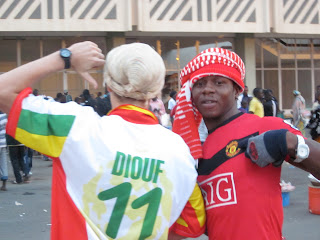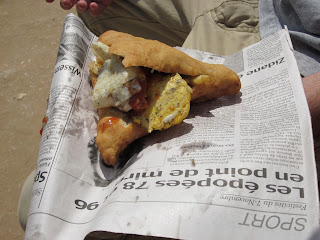
Even though I visited Touba as a part of my religious retreat to Khelkom to celebrate the birthday of the Prophet Mohammad, I feel it deserves a sperate post because I didn’t want it to get lost in my dense report of the Gamou. For me in my attempt to get back to Dakar Touba was both a welcomed beacon of hope that meant I was finally on my way, while also yet another setback in getting back. I am, however, very glad to have seen some of the town and the incredible Mosque. Touba is the spiritual hub for Senegal’s largest Muslim brotherhood, the Mourides. It is home to the Marabouts, who are the spiritual guides within the brotherhood whose status follows a patrilineal line of inheritance.
Islam is everywhere in this town. Prayer beads were in nearly everyone’s hands, we walked by about 5 Koranic schools and no “normal” ones, and it was the only place thus far where I did not see any soccer fields or anyone playing. Whether that meant everyone was too preoccupied with their religious practices or that that kind of recreation is not permitted I don’t know. It was also hard to ignore the fact that everyone actually seemed to be noticeably well-off, generally and relatively speaking (presumably because of the large concentration of wealth here that is a result of the Mouride-controlled industries all over Senegal including transportation and groundnuts). In addition to being the religious capital of the Mouride brotherhood, it is also the economic epicenter.
The most remarkable manifestation of this wealth is the Grand Mosque of Touba. After having seen countless mosques around Dakar and elsewhere in the world, this huge construction was in a class all by itself. I could not compare to anything I’ve ever seen before, except for the Disney castle at the beginning of the animated films. The majority of it, including four out of the five towers, is made from some pink marble-ish stone that was imported from Italy I think. The fifth tower (five towers, five pillars of Islam, every part of the construction of this mosque has some meaning) might easily be the tallest single structure I have seen in Senegal and can be seen throughout the city.
If the construction is impressive, the artwork may be even more so. A bunch of domes that make up the ceiling are intricately painted with striking colors and unique designs that are changed on a yearly basis by a collaboration of Moroccan and Senegalese artists.
After a full tour of the entire Mosque, which includes multiple Marabout resting places and a huge courtyard-type open space, we walked around the town a bit, seemingly yet another tactic used by my older brother to waste time because he knew it would be a while until we were finally on the road again bound for Dakar. Sure enough that was the case, and my chaotic and frustrating travel experience picked up right where it left off.

























